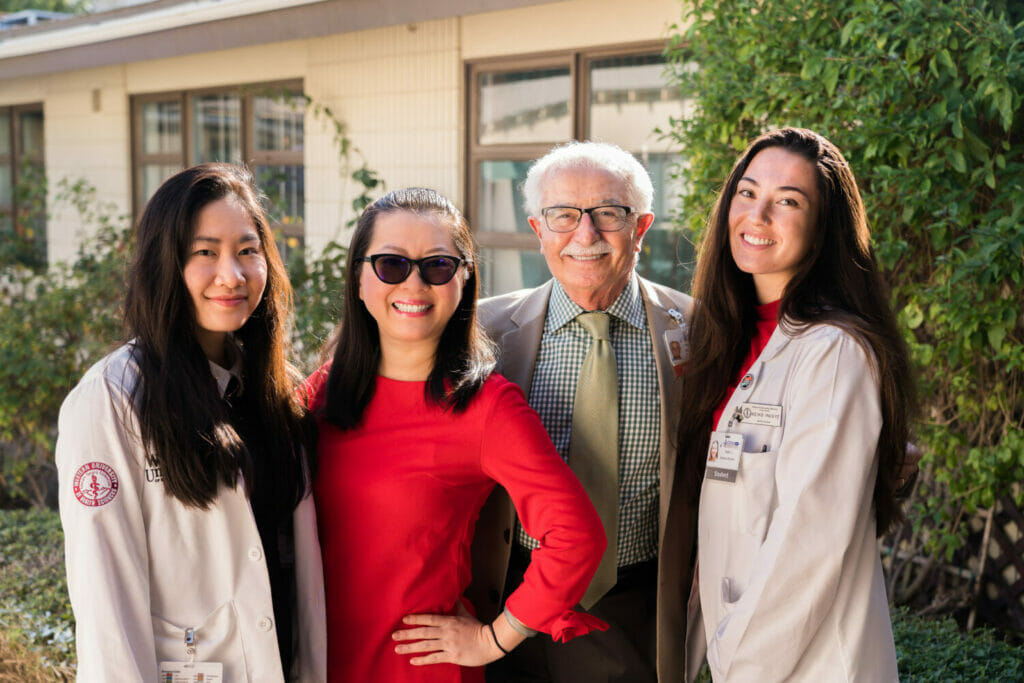The benefit of pharmacy-physician cross training for medical students

By Keiko Inouye and Anh-Tram Bui
Communication and collaboration between different medical providers ensures the best possible patient care. This relationship expands beyond the medical team, as patients are at the center of an entire network of multidisciplinary health care teams. Effective communication between these teams has been shown to contribute to higher patient satisfaction, reduced medical bills, reduced medical errors, and improved patient safety¹. Many health sciences programs have established their own interprofessional training opportunities to address these competencies. These trainings have been shown to improve student-physician communication, empathy, and info gathering².
As medical students, it is rare that we are given an opportunity to spend a day in the life of another health care leader outside of our profession. Over the course of our four-week psychiatric rotation, we were allowed the opportunity to shadow the hospital’s clinical pharmacist one-on-one on multiple occasions. We delved beyond the standard scope of training and
learned how to correctly enter patients’ prescriptions and consider the nuances beyond a simple “order entry.” While shadowing, we were made aware of intricacies that exist within the relationship between physician and clinical pharmacist, as well as clinical pharmacist and patient.
Through shadowing clinical pharmacist Carol Yuan, PharmD, BCPP, APh, at Aurora Charter Oak Hospital, Cardinal Health, the most important lesson we learned as physicians-in-training was one in communication. While seemingly obvious, changing the way we communicate with the clinical pharmacist via orders can help to create a much more efficient
transaction. Being more specific in our reasoning for orders can give the clinical pharmacist a clearer understanding for the rationale behind them. Rather than listing “thoughts” as the rationale for psychotropic medications, for example, a simple change to “hallucinations” or “depression” can better clarify the medication’s intended purpose. Additionally, giving the clinical pharmacist a clearer understanding of how we prefer to approach treatment plans provides a reference point for medication recommendations as well as counseling and education to patients. Understanding a prescriber’s preferred treatment pattern can improve patient safety and minimize the number of calls or contacts between the prescriber and the clinical pharmacist. This understanding cultivates a mutual respect and makes both parties more willing to collaborate.
When it comes to placing the orders, changing the way we place orders can also optimize the process. Consolidating previous and new orders when possible can contribute to a more streamlined system for improving patient compliance. If a patient is having to take multiple small-dose pills a day, then the clinical pharmacist might recommend changing the medication
to a single pill at a larger dose. By reducing the number of pills, patients are more likely to comply with their medications and show up for visits. Additionally, by minimizing medication errors due to miscommunicated written orders and maximizing productive time for both clinical pharmacists and prescribers, we can improve patient safety.
This training also gave us insight into The Joint Commission’s regulations regarding pain assessment and management. We learned that each pain medication ordered must clearly describe both the type of pain and severity it is indicated for. Furthermore, these medications must not overlap in pain type and severity. For example, only one medication should be listed for leg pain with mild to moderate severity. If another medication is indicated for mild to moderate pain, it must clearly denote that it is for pain other than the leg pain. By providing distinct indications for each pain medication, frontline staff can quickly provide the correct medication, rather than attempting to decipher the order list to determine the prescriber’s
intentions for each medication. This ultimately cuts down on unnecessary communication to clarify orders, creating more streamlined and reliable healthcare services.
Ultimately, healthy collaboration between physicians and clinical pharmacists results in improved patient care and efficiency within the workplace. One site-specific collaboration effort that we were able to observe was the development of a protocol to combat the high incidence of antipsychotic side effects seen at the hospital. Together, both clinical pharmacists and
physicians devised a plan to administer a short-term prophylactic dose of medication in combination with antipsychotics for new patients who were more at risk for developing side effects. This effort took much time and research and communication between the hospital’s physicians and clinical pharmacists. Since adopting this protocol, severe adverse reactions to
these medications plummeted in numbers. Efforts like these exemplify what can be achieved with proper interprofessional collaboration in a health care setting.
This experience granted us the opportunity to work directly with clinical pharmacists and learn how to improve our collaboration as prescribers. After this experience, we have been given insight into pharmacy as a profession; we have gained a greater trust and appreciation for their knowledge and contributions to the medical team. We have also learned that clinical
pharmacists depend on physicians as much as physicians depend on clinical pharmacists, deepening our appreciation. This experience has been tremendously valuable to our education as health care professionals, and what we have learned over the course of these four weeks will shape the way we practice and interact with our health care teams.
References:
1) Jung, H., Park, K. H., Min, Y. H., & Ji, E. (2020). The effectiveness of interprofessional
education programs for medical, nursing, and pharmacy students. Korean journal of
medical education, 32(2), 131–142. https://doi.org/10.3946/kjme.2020.161
2) Wilson, A. J., Palmer, L., Levett-Jones, T., Gilligan, C., & Outram, S. (2016).
Interprofessional collaborative practice for medication safety: Nursing, pharmacy, and
medical graduates’ experiences and perspectives. Journal of interprofessional care,
30(5), 649–654. https://doi.org/10.1080/13561820.2016.1191450



